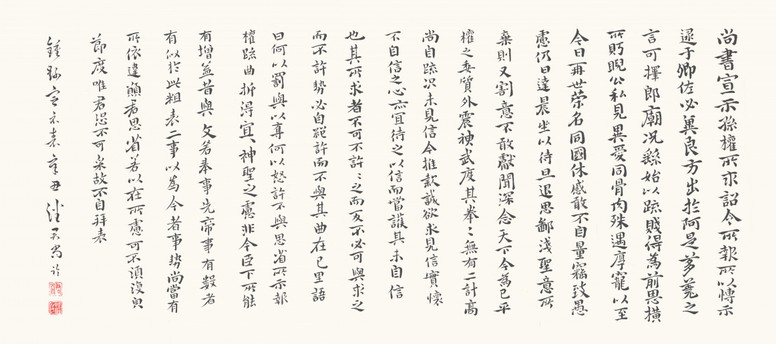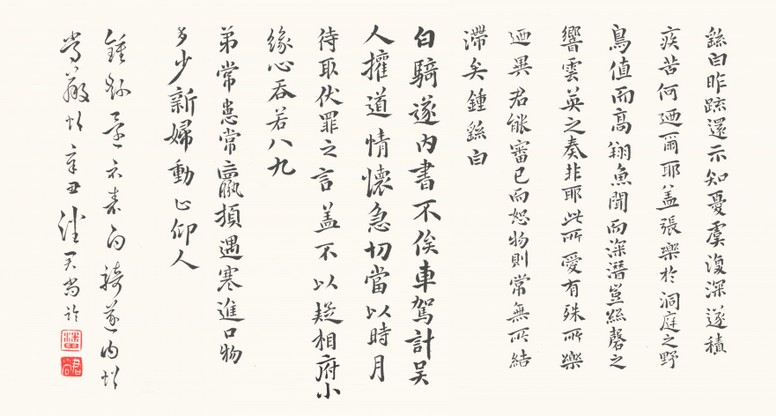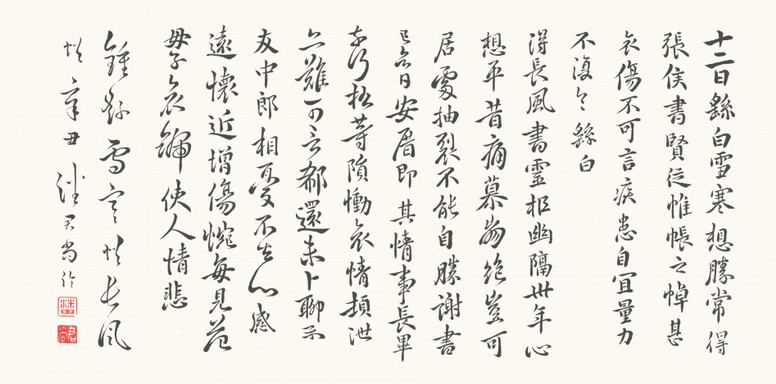Galleries and Translations > Models of Masterpieces > Models of miscellaneous Exemplary Masterpieces by Zhong Yao 臨鍾繇諸法帖
Models of miscellaneous Exemplary Masterpieces by Zhong Yao 臨鍾繇諸法帖
Historical information
(I)
Zhong Yao (鍾繇, 151-230AD) of the Three Kingdoms period (三國時代) was revered as the top calligrapher of the standard script throughout Chinese history (1). He once served under the venerable Cao Cao (曹操) and was also a respectable officer during his times (2). Although he was widely known for his standard scripts, his semi-cursive scripts were regarded by Zhang Huaiguan (張懷瓘) as masterpieces (神品) and his cursives scripts as wonderful works (妙品) (3). As such, he is crowned as one of the “Four Meritous Calligraphers (四賢) ” in Chinese history (4). It is therefore completely incorrect to assert Zhong Yao did not scribe in cursive script at all (5). Indeed, “The Sage of Calligraphy (書聖)” Wang Xizhi (王羲之) first learned calligraphy by modelling after the styles of Zhong Yao (6).
(II)
Zhong Yao’s calligraphy inherited from those of Cao Xi (曹喜), Cai Yong (蔡邕), and Liu Desheng (劉德昇) (7), and his styles carried a perfect balance of boldness and gentleness (8). Within his dynamic dots and strokes, his scripts were classically elegant (9). Many admired his works for their natural beauties rather than as products of superior skills (10). Most, if not all, unrivalled masterpieces indeed bear the artistry derived from nature. This is why master calligrapher Huai Su (懷素) aspired to learn from the natural patterns of clouds rather than the bold tracks of fabricated roads (11).
(III)
The calligraphies presented below are my models of Zhong Yao’s handwriting found in Chunhua Imperial Archive of Calligraphy Exemplars (《淳化閣帖》). Supposedly, these handwritings were short letters and memos scribed by Zhong. Although their authenticities are questionable, they are still often regarded as Exemplary Masterpieces (法帖) for calligraphers to study and observe. In the art of Chinese calligraphy, "帖(pronounced as Tie)" refers to an exemplary work that should be studied by all.
KS Vincent Poon, May. 2021
Footnotes
(1) 張懷瓘, 《書斷》:「真書絕世.」 見張彥遠 《法書要錄》. 北京: 人民美術出版社, 1984, p.263.
(2) 陳壽,《三國志》魏書卷十三. 臺北: 中華書局, 1968, p.1.
(3) 張懷瓘 ,《書斷》. 見張彥遠 《法書要錄》 . 北京: 人民美術出版社, 1984, p.248, 253, 264.
(5) Ibid., pp.88-89.
(6) 李長路, 王玉池,《王羲之王獻之年表與東晉大事記》. 重慶: 重慶出版社, 1992, p.6.
(7) 張懷瓘, 《書斷》:「繇善書, 師曹喜、蔡邕、劉德昇.」 見張彥遠 《法書要錄》. 北京: 人民美術出版社, 1984, p.263.
(8) 張懷瓘, 《書斷》:「剛柔備焉.」 Ibid.
(9) 張懷瓘, 《書斷》:「點畫之間, 多有異趣, 可謂幽深無濟, 古雅有餘.」 Ibid.
(10) 庾肩吾, 《書品》: 「鍾書天然第一, 功夫次之.」 見《歷代書法論文選》。上海: 上海書畫出版社, 1979, p. 87.
(11) 陸羽, 《唐僧懷素傳》: 「貧僧觀夏雲多奇峯, 輒嘗師之. 夏雲因風變化, 故無常勢, 又遇屈折之路, 路不自然.」See KS Vincent Poon & Kwok Kin Poon, English Translation of Classical Chinese Calligraphy Masterpieces 英譯法書. Toronto: The SenSeis, 2019, pp.110-111.
A model of Xuan Shi Tie or Xuan Shi Biao (宣示帖/宣示表)
36 X 82 cm
Click to Enlarge. Reserved, not available in shop.
Xuan Shi Tie or Xuan Shi Biao (宣示帖/宣示表):
Original Classical Chinese: 尚書宣示。孫權所求,詔令所報。所以博示逮於卿佐。必冀良方出於阿是。蒭蕘之言可擇郎廟。况繇始以疏賤,得為前恩。橫所盱(?)睨,公私見異。愛同骨肉,殊遇厚寵,以至今日,再世榮名,同國休戚。敢不自量,竊致愚慮,仍日達晨,坐以待旦。退思鄙淺,聖意所棄,則又割意。不敢獻聞。深念天下今為已平。權之委質,外震神武,度其拳拳,無有二計,高尚自疏。况未見信。今推款誠,欲求見信,實懷不自信之心。亦宜待之以信,而當護其未自信也。其所求者,不可不許。許之而反,不必可與。求之而不許,勢必自絕。許而不與,其曲在己。里語曰:「何以罰?與之奪;何以怒?許不與。」思省所示報權疏,曲折得宜。神聖之慮,非今臣下所能有增益。昔與文若奉事先帝,事有數者,有似於此。粗表二事,以為今者事勢,尚當有所依違。願君思省。若以在所慮,可不須復完節度。唯君恐不可采,故不自拜表。
English: NA. The translation is not provided here, for the authenticity of the text cannot be completely verified.
A model of Hai Shi Tie or Hai Shi Biao (還示帖/還示表) , Bai Qi Sui Nei Tie (白騎遂內帖), and Chang Lei Tie (常羸帖)
36 X 67 cm
Click to Enlarge. Reserved, not available in shop.
Hai Shi Tie or Hai Shi Biao (還示帖/還示表):
Original Classical Chinese: 繇白。昨疏還示。知憂虞復深。遂積疾苦,何乃爾耶﹖蓋張樂於洞庭之野。鳥值而高翔、魚聞而深潛,豈絲磬之響、雲英之奏非耶﹖此所愛有殊,所樂乃異。君能審己而恕物,則常無所結滯矣。鍾繇白。
English: NA. The entire phrase may not be translated, for the context in which it was written is unknown or uncertain.
Bai Qi Sui Nei Tie (白騎遂內帖):
Original Classical Chinese: 白騎遂內書。不俟車駕。計吳人權道,情懷急切。當以時月待取伏罪之言。蓋不以疑相府。小緣心吞若八九。
English: NA. The entire phrase may not be translated, for the context in which it was written is unknown or uncertain.
Chang Lei Tie (常羸帖):
Original Classical Chinese: 弟常患。常羸頓。遇寒進口物多少。新婦動止仰人。
English: NA. The entire phrase may not be translated, for the context in which it was written is unknown or uncertain.
A model of Xue Han Tie (雪寒帖) and De Chang Feng Tie (得長風帖)
35 X 71 cm
Click to Enlarge. Reserved, not available in shop.
Xue Han Tie (雪寒帖):
Original Classical Chinese: 十二日,繇白。雪寒。想勝常。得張侯書。賢從帷帳之悼,甚哀傷,不可言。疾患自宜量力。不復一一。繇白。
English: NA. The entire phrase may not be translated, for the context in which it was written is unknown or uncertain.
De Chang Feng Tie (得長風帖):
Original Classical Chinese: 得長風書。靈柩幽隔卅年,心想平昔,痛慕崩絕豈可居處。抽裂不能自勝。謝書已具日安厝。即其情事長畢。奈何。松等隕慟,哀情頓泄,亦難可言。郗還未卜。聊示。友中郎相憂不去。心感遠懷。近增傷惋。每見范母子哀號,使人情悲。
English: NA. The entire phrase may not be translated, for the context in which it was written is unknown or uncertain.


